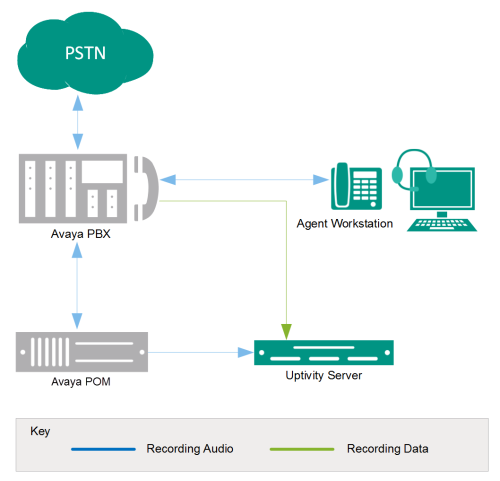Avaya Proactive Outreach Manager (POM) Integration Overview
The Avaya POM integration is designed to work with active VoIP (using DMCC) as an audio source. Call control and metadata are provided by the Avaya POM dialer.
| Component | Function |
|---|---|
| Avaya PBX | PBX component that controls the audio being presented to and from digital phones, IP phones, or both. |
| Avaya POM | Dials outbound calls. Directs the PBX to connect calls to agents. Sends events (such as CALLCONNECT, CALLDISCONNECT, and so forth) and other data (such as Agent ID) to the Uptivity server. |
| Uptivity Server |
Provides an interface to the Uptivity recording node to start/stop call recording. Generates call records in the Uptivity database that store Agent ID and other information. |
Avaya POM is used to design and deploy outbound voice, SMS, and e-mail campaigns. The Uptivity integration with POM requires a DMCC integration for its audio source. Refer to the appropriate guide for the audio source integration for additional knowledge and requirements, available from the Recording Integrations Overview
- Avaya DMCC-MR
- Avaya DMCC-SO
- Avaya DMCC-SSC
The customer is expected to have a working environment with Avaya Proactive Outreach Manager. No specific configuration of Avaya POM components is required to integrate with the Uptivity software.
Terminology
To ensure a common frame of reference, we use the following terms in conjunction with Avaya integrations:
Customer Responsibilities
Customers are responsible for supplying the physical connection(s), IP connection(s), or both to the
Detailed steps for the Avaya configuration can be found in Avaya’s documentation, which is available on the Avaya website or from your Avaya vendor. You should always use the appropriate guides from Avaya to install and configure Avaya components.
Configure Audio Source
Perform any required configuration for the Avaya DMCC audio source integration. Refer to the appropriate guides, available from the Recording Integrations Overview
- Avaya DMCC-MR
- Avaya DMCC-SO
- Avaya DMCC-SSC
Provide POM User Account
Uptivity requires a user account on the Avaya Proactive Outreach Manager to receive events. Whether an existing account is used or a new account is created specifically for this purpose, you will need to provide the username and password to your Uptivity installation team.
Provide POM Server and Port
Uptivity uses the POM server address and port to communicate with the server for metadata and call information. You will need to provide this information to the Uptivity installation team.
POM Administration
Once installation and configuration are completed by the Uptivity installation team, some adjustments may need to be made as your needs evolve. During ongoing use of the system, your Uptivity administrator may need to configure new channels or reconfigure existing channels.
This integration works with active VoIP (using DMCC) as an audio source. If you add or reconfigure channels, you will need to follow any procedures specific to those audio sources as found in the appropriate customer guide. Contact Uptivity Support if assistance is required.
Avaya Requirements
Software
- Avaya POM Release 3.0 or newer
These requirements are in addition to the audio source requirements; refer to the relevant customer guide for details.
Software and Licensing
No additional software or licensing is needed.
Uptivity Requirements
Hardware, Software, and Licensing
General Uptivity hardware and software requirements are specified in the customer guide for the audio source integration. Those guides also explain the licensing requirements. No additional Uptivity licensing is needed.
Specific hardware and system software required for your implementation is determined by Uptivity Sales Engineering during the discovery and system design process. No system hardware or software should be purchased or requisitioned until the final system design document is complete.
